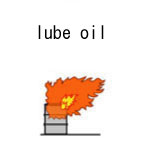| Case Name |
Emergency shutdown caused due to ignition of bearing insulation of a steam turbine at a nuclear power plant |
| Pictograph |

|
| Date |
December 12, 2002 |
| Place |
Tsuruga, Fukui, Japan |
| Location |
Atomic power plant |
| Overview |
A nuclear reactor was shut down due to a small fire at a high-pressure steam turbine bearing in a nuclear power plant. The fire occurred when the gas extractor which kept a bearing oil main tank in a vacuum was switched to a spare air ejector. The ejector outlet U-seal portion became clogged, could not function. Then foggy lubricating oil sprayed, permeated into the insulation and ignited. There was an oversight in maintenance and countermeasures for the failure of small parts of auxiliary equipment. |
| Incident |
Smoke came out of insulation near a high-pressure steam turbine bearing of a nuclear power plant that was on-stream at the rated capacity. A fire occurred while disconnecting work for insulation was being done. Therefore, the nuclear reactor was shut down. There was no influence of radioactivity on the environment. |
| Processing |
Consumption and usage |
| Process Flow |
Fig2.Mechanism of ignition from insulation piping
|
| Substance |
Lubricating oil |
| Type of Accident |
Fire |
| Sequence |
About 19:00 on December 12th, 2002, when cleaning up of an oil spill was conducted on the floor near the high-pressure steam turbine on the third floor of the turbine building, smoke came out from near the high-pressure turbine casing insulation.
19:39, ignition occurred during disconnection work of insulation. The fire was extinguished by a fire extinguisher immediately.
20:51, a fire occurred again. Fire extinguishing work was carried out.
21:00. the nuclear reactor was stopped manually. |
| Cause |
A gas extractor (a vacuum pump) was used to maintain a vacuum at the main lube oil tank of a turbine shaft. This was switched to a spare air ejector to repair the extractor. The air ejector did not work, and foggy leaking oil from the bearing jetted, and it was observed to have permeated into the insulation. The permeated oil ignited at a lower temperature than usual. As the U-seal portion at the ejector outlet was clogged, the ejector function did not work properly. |
| Response |
Fire extinguishing with a fire extinguisher and an emergency shutdown of the nuclear reactor. |
| Countermeasures |
The U-tube was changed to a new structure for easy cleaning. A cover and a leakage oil receiver were installed so that permeation of leaking oil into the insulation should not be generated.
The above are countermeasures to cope with the problem. It might be necessary to restudy influences and countermeasures when inconspicuous parts fail. Careful studies might be performed in the field related to atomic energy, but further strict study must be done, considering the molten sodium leakage at "Monju", etc. |
| Knowledge Comment |
In a large system, some parts are overlooked because they are inconspicuous. Such an oversight of small parts is not allowed, and they should be treated in the same way as the main equipment. Accidents often occur at very small parts that had not been studied sufficiently. |
| Background |
1. Omission in daily management or insufficient education and training.
The cause lay in parts of the spare machine of auxiliary equipment. Expected functions cannot be achieved if the condition of the parts is bad. Did the design engineer and machine staff understand this? Operators might not have sufficient education and overlooked the results of inspection, because the parts were considered too small.
2. The countermeasure had not been prepared. The person concerned with the operation knew that foggy bearing oil was sprayed when the equipment was not evacuated to a full vacuum. However, there were no countermeasures. A receiver for foggy sprayed oil was installed after the problem arose. The countermeasure was at a level not required in a normal chemical plant. In the case of a nuclear reactor, a shutdown is required if there is any kind of problem. Considering the unique nature of atomic energy, a countermeasure should have been studied. This can be considered insufficient prior study. |
| Reason for Adding to DB |
Example of shutdown of a large system caused due to tiny trouble at small part of auxiliary equipment |
| Scenario |
| Primary Scenario
|
Poor Value Perception, Poor Safety Awareness, Inadequate Risk Recognition, Insufficient Analysis or Research, Insufficient Prior Research, No Care Poor Condition of Small Parts, Carelessness, Insufficient Understanding, Insufficient Recognition of Risk, Planning and Design, Poor Planning, Insufficient Design, Regular Movement, Careless Movement, Overlooking, Bad Event, Mechanical Event, Blockade, Secondary Damage, External Damage, Leakage/Fire, Loss to Organization, Social Loss, Trust Damage, Loss to Organization, Economic Loss, Sales Decrease, etc.
|
|
| Sources |
Ministry of Economy, Trade and Industry, Nuclear safety and Protection Agency, Cause manual stoppage of Japan Atomic Power Inc. Tsuruga Nuclear Power Plant, Unit No.2 and report from Japan Atomic Power Inc. concerning countermeasures and research results. Nuclear Safety and Protection Agency home page (2002)
Ministry of Economy, Trade and Industry, Nuclear Safety and Protection Agency, Manual stoppage of Japan Atomic Power Inc. Tsuruga Nuclear Power Plant, Unit No.2. Nuclear Safety and Protection Agency home page (2002)
|
| Physical Damage |
The insulation burned at the cover of a high-pressure steam turbine. |
| Field |
Chemicals and Plants
|
| Author |
KOBAYASHI, Mitsuo (Office K)
TAMURA, Masamitsu (Center for Risk Management and Safety Sciences, Yokohama National University)
|
|